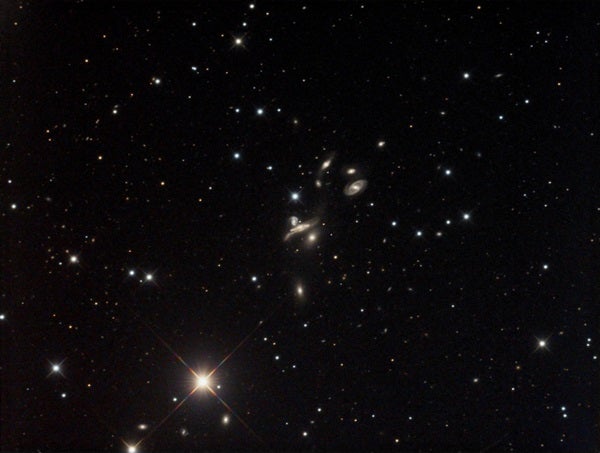When it comes to obscure objects, Copeland’s Septet (also called Hickson Compact Group 57) ranks with the best of them. Ralph Copeland discovered this group in the spring of 1874 while employed by William Parsons, Earl of Rosse, in Ireland. He was using the Leviathan, a 72-inch speculum mirror telescope at Birr Castle. At that time, it was the largest telescope in the world, enabling him to pick up faint galaxies with relative ease.
Located 3° northwest of 93 Leonis, this group is unusual in that it is dominated by barred spirals. A 12th-magnitude foreground star sits in the middle. NGC 3753 is the brightest and largest member. Also called Hickson 57a, it is magnitude 13.6 and appears edge-on, covering 1.7′ by 0.4′. In images, it sports a dark lane; blue, knotty arms; and faint extensions that may be associated with a collision and appear to stretch hundreds of thousands of light-years to neighboring NGC 3746.
NGC 3746 (Hickson 57b) is the group’s second-largest member. This magnitude 14.2 galaxy has produced two recorded supernovae: 2002ar and 2005ba. A barred spiral, this galaxy has a more distinct inner ring and S-shaped spiral halo than fellow group member NGC 3745. The latter is a tiny (0.4′ by 0.2′) magnitude 15.2 barred spiral also cataloged as Hickson 57g. Photos show it as compact with an extended faint spiral halo.
Although comparable to NGC 3745 in size, NGC 3754 (Hickson 57d) is magnitude 14.3. NGC 3748 (Hickson 57e) is a magnitude 14.8 edge-on lenticular or Sa-type spiral with a narrow dust lane. It spans 0.7′ by 0.4′. NGC 3750 (Hickson 57c) is a magnitude 13.9 lenticular galaxy 0.8′ by 0.7′ in size. It shows little structure in photos. NGC 3751 (Hickson 57f) is as bright as NGC 3750 and an elongated 0.8′ by 0.5′. An eighth member, the barred spiral PGC 36010 with a magnitude of 17.4, was too faint for Copeland to observe.
Make sure to explore Astronomy’s full list of 101 cosmic objects you must see. New entries will be added each week throughout 2022.
To get the latest astronomical news and observing content delivered directly to your door, subscribe to Astronomy magazine today!










